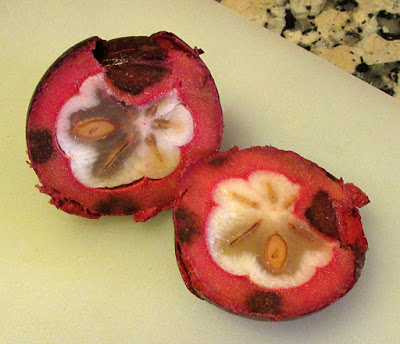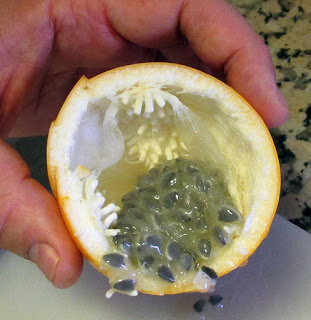San Geraldo made his daily stop at Ana Crespillo’s fruit market here in Los Boliches (click for the Facebook page) and she had him try two new-to-him fruits. He liked them so much that he bought two of each so I could share in the ecstasy.
Mangostán
The first is called Mangostán. I’ve looked it up and learned the English name is Purple Mangosteen. It’s a tropical evergreen tree. The fruit I tasted had a subtle fragrance and a mild, pleasant, and very slightly tart flavor. It’s got little nutritional value, but that’s not the only reason I eat.
[Postscript: Although there is no scientific evidence that Mangostán has nutritional value, there have been no studies done on the fresh fruit — only canned fruit or juice. It is reputed to have quite a number of benefits.]
 |
| MANGOSTÁN (PURPLE MANGOSTEEN). |
 |
| ABOUT THE SIZE OF A TANGERINE. |
 |
| ONLY THE WHITE PART OF THE FRUIT IS EDIBLE. |
Granadilla
The second fruit is called granadilla. Native to the Andes Mountains, it’s known as grenadia or passion fruit in other parts of the world.
Pictured below in San Geraldo’s unusually large hand (he’s got two of them and they are well-balanced by his unusually large feet), it looks much smaller than it is. I added a photo at the bottom of a granadilla alongside a plum-sized mangostán, so you can see the difference.
When the granadilla is sliced open, there’s a gelatinous pulp surrounding the seeds. You simply pour that into your mouth. It looks like mucous and it tastes like nectar from the Gods. Sweet and smooth. And containing Vitamins A, C, and K, phosphorous, iron, and calcium. I could develop a passion for it.
 |
| GRANADILLA. |
 |
| I WAS SUPRISED BY THE PERFECT FLAVOUR AND TEXTURE. |
 |
| IT EVEN HAS BUILT-IN PADDING TO PROTECT THE SEEDS. |








